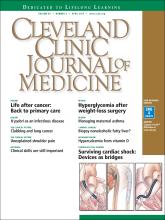ABSTRACT
For patients in cardiogenic shock, several devices can serve as a “bridge,” ie, provide circulatory support and allow the patient to live long enough to recover or to receive a heart transplant or a long-term device. Options include an intraaortic balloon pump, TandemHeart, Impella, extracorporeal membrane oxygenation (ECMO), and CentriMag. Which device to use depends on individual patient needs, local expertise, and anatomic and physiologic considerations.
- Copyright © 2017 The Cleveland Clinic Foundation. All Rights Reserved.
- Mehdi H. Shishehbor, DO, MPH, PhD⇑
- Medical Director, Endovascular Services, Department of Cardiovascular Medicine, and Associate Program Director, Interventional Cardiology, Heart and Vascular Institute, Cleveland Clinic
- ADDRESS:
Mehdi H. Shishehbor, DO, MPH, PhD, Heart and Vascular Institute, J3-05, Cleveland Clinic, 9500 Euclid Avenue, Cleveland, OH 44195; shishem{at}ccf.org
- Nader Moazami, MD
- Shinya Unai, MD
- W. H. Wilson Tang, MD
- Center for Clinical Genomics, Department of Cardiovascular Medicine, Department of Cellular and Molecular Medicine, Genomic Medicine Institute, Critical Care Center, and Transplantation Center, Cleveland Clinic
- Professor, Cleveland Clinic Lerner College of Medicine of Case Western Reserve University, Cleveland, OH
- Edward G. Soltesz, Md, MPH
ABSTRACT
For patients in cardiogenic shock, several devices can serve as a “bridge,” ie, provide circulatory support and allow the patient to live long enough to recover or to receive a heart transplant or a long-term device. Options include an intraaortic balloon pump, TandemHeart, Impella, extracorporeal membrane oxygenation (ECMO), and CentriMag. Which device to use depends on individual patient needs, local expertise, and anatomic and physiologic considerations.
- Copyright © 2017 The Cleveland Clinic Foundation. All Rights Reserved.






